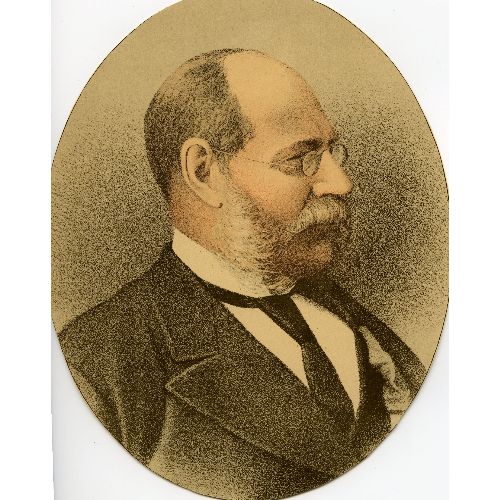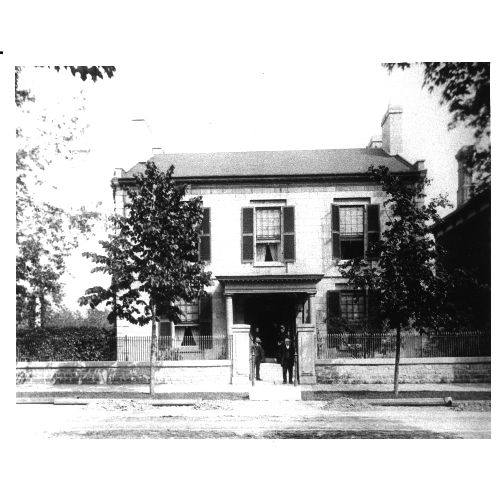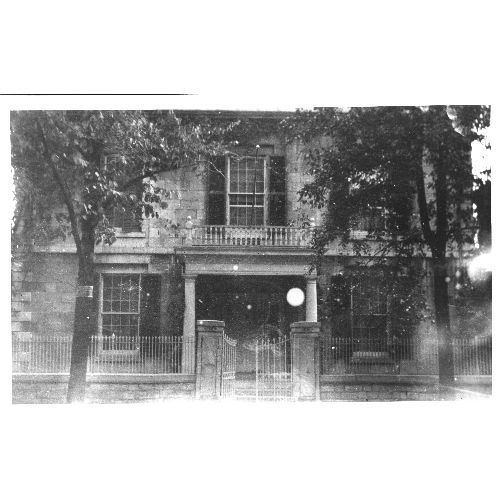Period : 1800-1850
The stone house we are looking at was built in 1834 for John Solomon Cartwright (1804-1845), a lawyer, judge, banker, and Member of the Legislative Assembly of Upper Canada. His father, Richard Cartwright, had brought Joe Gutches to Kingston as a slave. Joe spent his last years living in this house with the son.
The presence of the first black slaves in Kingston in the 1780s coincided with the arrival of the United Empire Loyalists, displaced because of the American Revolution. The Reverend John Stuart, minister of St. George’s Church (now Cathedral) brought his slaves with him, as did Molly Brant, a Mohawk who owned three slaves, Abraham Johnston, Juba and Jane Fonda. Such other notable Loyalists as the Everetts, Herkimers, Fairfields and Cartwrights owned slaves and brought them here, as they were considered “personal property.”
We learn more about one of these slaves from the following newspaper article:
Died – On Sunday afternoon, Joseph Gutches, a coloured man, well known in Kingston, at the advanced age of 79. He was born in the State of New York, then a British Colony, and came to Canada about 1782, in the family of the late Hon. Richard Cartwright, and continued in the service of that gentleman or his sons every since, a period of 60 years. He remembered Kingston since 1784. He used to say that at that time with the exception of the old French fort and a few wooden houses, this place presented nothing to view but pine woods and girdled stumps – what a change he lived to witness. But few now remain of these early settlers – peace be unto them. (Chronicle & Gazette, 2 November 1842)]
Richard Cartwright was born in Albany, N.Y., on 2 February 1759 and died in Montreal 27 July 1815. Being considered a committed Loyalist, he was expelled from New York in October 1777. He served as secretary with John Butler’s Rangers based at Niagara, and spent 1778 and 1779 going on military expeditions into northern New York. Not only did this help him gain valuable experience in provisioning the military but it also enabled him to make important business contacts. In 1780 he left the military and partnered with John Hamilton as merchants; they soon became heavily involved in the flour and pork trade. They won supply contracts for the Kingston garrison and later for other Upper Canada garrisons. By 1785 Richard Cartwright moved to the Kingston area, where he became an influential commercial, legal, political, and religious leader. He became a justice of the piece, judge, militia officer (1793) and legislative councilor (1792). Politically, he often quarreled with Upper Canada’s first Lieutenant Governor, John Graves Simcoe, as the two had different views of Upper Canada as a British colony. On the issue of slavery, however, they seemed to be in agreement, despite the fact that Cartwright was believed to have ten or more slaves during the Revolutionary war. In 1793 Simcoe instructed Attorney-General John White to introduce to the House of Assembly a bill for the gradual abolition of slavery. Of sixteen members of the Assembly, at least six were slave owners, and in the Legislative Council Peter Russell, Richard Cartwright and James Baby also were. But the bill passed unanimously in two weeks. In 1798, after Simcoe had left Upper Canada and White had lost his seat in an election, a Loyalist member introduced a bill into the House of Assembly permitting slaves to be brought in by immigrants. It passed by a vote of eight to four but, through the efforts of members Richard Cartwright and Robert Hamilton, the bill was bottled up in the upper chamber until the session ended.
In 1787 Joe was one of several black people who made presentations before an inquiry held by the authorities at Kingston to listen to grievances. Joe “appeared before the Board asserting that he was taken by the Indians and sold for a Slave for life but that he was at the time of his Capture bound only to serve until 21 years of age.”
In a letter dated at Cataraqui, 16 August 1787, Richard Cartwright informed Commissioners Collins and Powell what he knew of Joe’s history:
“As you have been so obliging to inform me, that my Negroe Man called Joe, has complained to you that he is illegally detained as a Slave, permit me in my own Vindication to represent to you what I know respecting him: -The original Proprietor of him was one Jonas Vrooman, of Schohary, in the State of New York, – In an Incursion of the Indians, during the late War, this Man was killed, and the Negroe brought to Niagara, he was there sold to a Mr. Dunn at that Time belonging to the Indian Department, by him resold to a Mr. Allan, and from Mr. Allan I purchased him for an hundred & twenty five Pounds New York Currency.-
I have every reason to believe that he was always legally a Slave, from the Testimony of People who knew him when in the Possession of Vrooman some of whom are still at Niagara, and particularly from his having been reclaimed last Year by the Heirs or Executors of the above mentioned Jonas Vrooman, who made Application on the Subject by Letter to the Rev’d Mr. Stuart of this Place; supposing, I presume, that they were by Treaty entitled to have him restored.”
A Valuation of Cartwright property for 1799 was noted in an inventory dated 1 April 1800. When all of Richard Cartwright’s assets are totaled up, including land, furniture, telescopes, globes, cattle and the services of Allan’s Negro, he was worth over £27,000.
Assessment records show that Joe was living here with the family of John S. Cartwright during the last years of his life.




